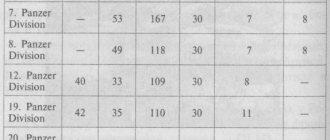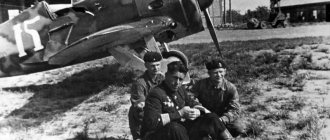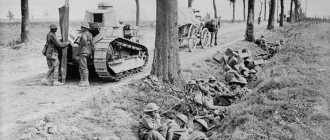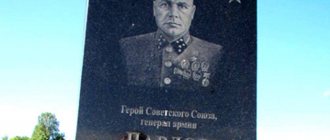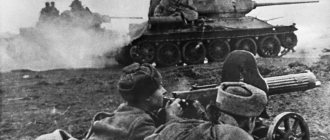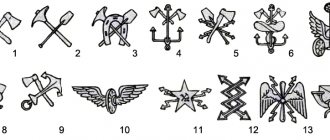How the breakthrough of the army group "Goth" was stopped
The offensive of the army group "Goth" began on the morning of December 12, 1942. Operating from the Kotelnikovo area in a general direction to the northeast, the Germans delivered the main blow on a narrow section of the front along the Tikhoretsk-Stalingrad railway.
Here the 6th and 23rd tank divisions of the 57th tank corps advanced, which were opposed by the 302nd and 126th rifle divisions of the 51st army. A connection with the Paulus group was planned southwest of the station. Tundutovo.
Breakthrough of Soviet defense
The Soviet Headquarters and the command of the Stalingrad Front expected that the enemy would deliver the main blow from the Nizhne-Chirskaya area. This was the most logical step. From Kotelnikovo to the inner ring of the encirclement of the German army it was 110 km, Nizhne-Chirskaya was 45 km closer. This ensured the success of the first strike of the German strike force. For the offensive, the German 6th Panzer Division was divided into three motorized infantry groups and one strong Günesdorf armored group (commander of a tank regiment). The armored group included a tank regiment and an infantry battalion in an armored personnel carrier. Subsequently, with the spread of armored personnel carriers, the formation of armored groups became a common solution for German mobile formations.
After artillery preparation, the enemy broke through the defenses in the zone of the 302nd Infantry Division at the Kurmoyarsky stop. The German armored group not only broke through the defenses and went forward, but also attacked the rear of Soviet troops in Verkhne-Yablochny. With the onset of darkness, the advanced units of the 6th Panzer Division reached the southern bank of the river in separate sections. Aksai, and the 23rd Tank Division to the area north of Nebykov. The success of the first day of the offensive even surprised the Germans. H. Scheibert, commander of a tank company in the 6th division, wrote: “Given our own strength, fully confirmed by the success of the breakthrough, we still expected greater resistance, if not at the very forefront, then later in the lowlands near Nebykovo station. However, this lowland, used for the railway to Stalingrad and limited by deep gullies, could hardly be bypassed by motorized troops, which gave the defenders certain advantages.”
The command of Army Group Don believed that the main task had been solved - the Soviet front had been broken through. Further development of the offensive will not cause problems. However, the enemy underestimated the strength of Soviet mechanized formations in this direction. The defense of the 302nd Infantry Division collapsed, its defeated units retreated in small groups. A large gap opened up in the defensive formations of the 51st Army. A. I. Eremenko demanded that the commander of the 51st Army, Major General N. I. Trufanov, hold the line occupied by his troops and restore the situation in the sector of the 302nd Infantry Division. The 235th Flamethrower Tank Brigade and the 87th Infantry Division were sent from the front reserve to strengthen the army. Also, already on December 12, it was decided to deploy the 4th mechanized corps in the Kotelnikovsky direction. The haste of the actions of the Soviet command is evidenced by the fact that all units that came to hand were thrown to repel the enemy attack. Thus, the 235th separate flamethrower tank brigade was originally intended to suppress German infantry resistance centers in the Stalingrad area. Flamethrower tanks were not supposed to be used as linear vehicles. But now they had to face enemy tanks head-on.
German Ju-52 transport aircraft (Ju 52/3m) of the 1st Squadron of the 1st Special Purpose Squadron (1.KGrzbV1) deliver cargo to encircled units in Stalingrad. Photo source: https://waralbum.ru/
On December 13, the Germans launched an offensive. The 6th Panzer Division captured a bridgehead on the river. Aksai near Zalivsky, from here part of the forces advanced to the Verkhne-Kumsky farm and captured it. The 23rd Tank Division, advancing from the Nebykov area, also reached the river, seizing a bridgehead at the railway and highway bridge near Kruglyakov. In Scheibert's book, Fr.
On December 14, the command of the Stalingrad Front planned a counterattack on the flanks of the enemy group that had pulled ahead. It was planned to strike in converging directions by two groups. The first consisted of the 4th mechanized corps, 235th tank brigade, 234th tank regiment and 87th rifle division. The 13th Tank Corps was supposed to advance towards this group. To support the mobile forces, 100 fighters and attack aircraft of the 8th Air Army were allocated.
Thus, with the exit of the troops of the army group “Goth” to the river. Aksai there was a real danger of them breaking through the outer front of the encirclement and reaching the encircled army of Paulus. At the turn of the river Aksai-Esaulovsky, a fierce struggle unfolded, on the outcome of which the further development of events on the Soviet-German front largely depended. The German general Mellenthin assesses the significance of these battles as follows: “During this period, events full of tragedy took place, the historical significance of which is difficult to overestimate. It would not be an exaggeration to say that the battle on the banks of this unknown river led to the crisis of the Third Reich, put an end to Hitler’s hopes of creating an empire and was a decisive link in the chain of events that predetermined the defeat of Germany.” Indeed, the fate of the 6th German Army, the possibility of restoring the German front at Stalingrad, the outcome of the 1942 campaign and the future of the 1943 campaign depended on the outcome of this battle. The Wehrmacht desperately tried to maintain the strategic initiative.
Soviet artillerymen walk near a 76-mm regimental gun, model 1927, horse-drawn along a snow-covered road near Stalingrad
The Soviet Headquarters saw this threat well. Already on the evening of December 13, the original plan for Operation Saturn with access to Kamensk - Rostov was canceled. Now the main blow was directed not south to Rostov, but to the southeast, to Morozovsky. That is, a larger-scale operation, cutting off the escape routes of Army Group A in the Caucasus, was cancelled. It was necessary to prevent Paulus's 6th Army from breaking out. Therefore, the 6th Mechanized Corps was transferred to the Stalingrad Front in order to use it against the German strike group, which was eager to rescue Paulus’s army. The next day there was another major change of plans. Late in the evening of December 14, in a directive addressed to Vasilevsky, Stalin demanded that, in view of the changed situation in the south, the implementation of the first stage of Operation Ring to defeat the blockaded army of Paulus should be postponed. The 2nd Guards Army was proposed to move south by forced march and position it in the rear of the units operating against the enemy’s Kotelnikov group.
Thus, in the event of the defeat of the mechanized corps of the Stalingrad Front, fresh forces, including Malinovsky’s Guards Army, had to stand in the way of the German strike force. The problem was that by the evening of December 13, when the Germans reached the river line. Aksai, the 2nd Guards was still on the way. Some of the troops were still moving in echelons, while others were on the march to the unloading area. On December 15, the 2nd Guards Army was on the march, spread out along railways and dirt roads. Only by the evening of December 16, Malinovsky’s army reached the level of 120 unloaded trains (they were unloaded north of Stalingrad) out of 156. And from the unloading sites it was still necessary to go to the area south-west of the city. The convoys traditionally fell behind immediately, there was no fuel for vehicles, and there was no communication between units. That is, if the army group “Goth” had broken through Volsky’s mechanized corps and other troops, it would have been a disaster - the Germans would have had the opportunity to beat Malinovsky’s selected army piece by piece (more than 90 thousand soldiers).
On the morning of December 14, a fierce battle unfolded with renewed vigor. German troops sought to develop their success in the area of the Verkhne-Kumsky farm, which became the main hub of the struggle. Here were the most convenient roads from south to north to Stalingrad. The enemy's path from the north was blocked by the 1378th Infantry, 234th Tank Regiments, 235th Flamethrower Tank and 20th Separate Fighter Brigades. The advancing enemy was attacked from the air by Soviet attack aircraft, operating in groups of 4-6 aircraft. As a result, the 4th mechanized corps of General V.T. Volsky, which advanced to meet the advancing German troops, fought in the area of Verkhne-Kumskoye and Vodyanskoye. The 13th Tank Corps came close to the enemy in the area of the Biryukovsky junction and, entering the battle, pulled back part of the forces of the 23rd Tank Division. Thus, throughout the day, the 51st Army fought heavy battles with the advancing Goth strike force. H. Scheibert noted that December 14, 1942 was the day “the beginning of a three-day tank battle in the Kalmyk steppes, one of the largest and fiercest tank battles of the Second World War.”
On the same day, troops of the 5th Shock Army went on the offensive against the enemy operating in the Rychkovsky and Verkhne-Chirsky areas. After a stubborn battle, the 7th Tank Corps of Major General P. A. Rotmistrov, the 258th and 4th Guards Rifle Divisions drove the Germans back from the bridgehead, which eased the position of the 51st Army in the Kotelnikovsky direction.
Tankers of the 24th Soviet Tank Corps on T-34 armor during the liquidation of a group of German troops surrounded near Stalingrad
On December 15, stubborn fighting continued. The 4th mechanized corps (at that time it had more than 100 tanks) with reinforcement units fought for the Verkhne-Kumsky village, delivering a counterattack to the elongated wedge of the 6th tank division. The armored group of the 6th division found itself in a difficult situation. It had little infantry; the bulk of the division's motorized infantry was still on the southern bank of the Aksai and covered the flanks. In the afternoon, our troops drove the Nazis out of the Verkhne-Kumsky farm and threw them back to the river. Aksai. X. Scheibert, describing this battle, notes: “We were in a very bad mood... Rage, depression, combined with doubts and nervousness, took possession of us.” Citing an excerpt from the combat log of the 11th tank regiment, he writes: “By order of the division, the settlement (Verkhne-Kumsky - A.S.) was evacuated. Gunersdorf's group retreated south under cover of darkness to resupply with ammunition and fuel. This day cost the regiment heavy casualties.” Thus, our troops were able to stop the enemy at the turn of the river. Aksai.
Continuing the fight
On December 16, both sides were preparing to continue the battle and the fighting took place in separate areas. The troops of the Stalingrad Front, with stubborn defense, did not allow the enemy to reach the river. Myshkov, ensuring the approach and deployment of the 2nd Guards Army. The fighting took place in the area of Verkhne-Kumsky and Zhutov 1st. The most fierce battles took place in the Verkhne-Kumskoye area. Here the German 6th Tank Division was opposed by the 1378th Infantry Regiment under the command of Lieutenant Colonel M. S. Diasamidze, reinforced by the 1st Division of the 1058th Artillery Regiment.
The Germans were unable to penetrate the Soviet defenses. G. Doerr o.
The German command did not abandon attempts to break through to their own. The encircled army of Paulus was supposed to strike a counter-strike when Goth's troops marching towards it approached to a distance of 30 km. The strike group was 50 km from the target, it seemed that a little more and the task would be successfully completed. On December 17, the 6th, 17th (which completed the transfer to the battle area) and 23rd tank divisions, supported by infantry formations, rushed to attack in the Verkhne-Kumsky area. German tanks and motorized infantry, supported by aviation, furiously tried to break through between the Aksai and Myshkova rivers, tributaries of the Don. The terrain was difficult for battle - the steppe was cut by deep hollows and ravines, covered with deep snow.
The 6th and 23rd tank divisions struck to the north in order to bypass Zagotskot and recapture Verkhne-Kumsky. At the same time, motorized infantry, supported by assault guns, advanced from Zalivskoye. However, the Germans, having advanced a little, soon met fierce resistance and were unable to take Zagotskot. Overcoming stubborn resistance from Soviet soldiers, the enemy nevertheless reached Verkhne-Kumsky, but here again he encountered strong anti-tank defense. Despite air support, German tanks were unable to advance further. Here the defense was held by artillerymen of the artillery battalion of the 59th mechanized brigade and the 383rd anti-tank artillery regiment. Strong counterattacks by our tankers - the 55th separate tank regiment under Lieutenant Colonel A. A. Aslanov - forced the enemy to return to their original positions.
Scheibert O.
Also on this day, the 360th Mechanized Brigade and the 1378th Infantry Regiment distinguished themselves, repelling a number of fierce frontal enemy attacks in the area of the collective farm named after. March 8 and heights 130.1, 137.2. As a result, German troops were unable to capture Verkhne-Kumsky this time. The soldiers of the 20th separate anti-tank artillery brigade under the command of Major P. S. Zhelamsky fought heroically. Tank destroyers took up defensive positions at an altitude of 146.9, near the village. Thunderclap. The brigade, holding back the enemy, suffered heavy losses. On the same day, units of the 13th Tank Corps, Major General of Tank Forces T.I. Tanaschishin, fought west of Kruglyakov. Despite serious losses, the 4th Cavalry Corps continued to fight.
On December 17, the troops of the 2nd Guards Army, with the forces of two divisions and one mechanized corps, were just beginning to concentrate on the defensive line. By order of the commander of the Stalingrad Front, the 87th Rifle Division, the 4th Cavalry Corps and the 4th Mechanized Corps with all reinforcements were subordinated to the commander of the 2nd Guards Army. The troops of the 2nd Guards Army were tasked with defeating the enemy's Kotelnikov group on the approaches to the outer fortified perimeter of Stalingrad, with the immediate task of reaching the Aksai River.
Soviet Il-2 attack aircraft take off on a combat mission near Stalingrad
Soviet artillerymen from the crew of Sergeant Bardadymov are firing at enemy bunkers on the outskirts of Stalingrad from a 152-mm ML-20 howitzer gun, model 1937.
On December 18, the enemy launched the 17th Panzer Division (54 tanks), which had been brought into the battle area, on the offensive. Having crossed the river Aksai in its lower reaches, in the Generalovsky area, the Germans advanced to the collective farm named after. March 8, 7 km west of Verkhne-Kumsky. The headquarters, political department and medical unit of the 36th mechanized brigade of the 4th mechanized corps were located here. They found themselves under enemy attack. The death of all people was avoided, but the settlement had to be abandoned. In the evening, our troops restored the position, knocking out the enemy. On this day, the German 6th Panzer Division resumed its attack on Verkhne-Kumsky. The attacks of German tanks and motorized infantry were supported by massive strikes by attack and bomber aircraft. The 1378th Infantry Regiment, under the command of Lieutenant Colonel Diasamidze, took the brunt of the attack and repelled three enemy attacks. The soldiers of the 382nd Anti-Tank Artillery Regiment and all other units and units of the 4th Mechanized Corps also fought staunchly.
During the fierce battle, more than once Soviet soldiers showed unique examples of heroism worthy of historical paintings. So, among them there were 24 fighters defending height 137.2. The rifle company of the 3rd battalion of the 1378th rifle regiment under the command of senior lieutenant N.P. Naumov, together with a platoon of anti-tank rifles that joined it at night, repelled one after another German attacks. Our soldiers destroyed 18 tanks and many enemy soldiers and officers. Only in the afternoon did the Germans manage to capture height 137.2. Heroes died the death of the brave. By the end of the day, with a strike from the tank regiment of AAslanov and the reserve unit of Diasamidze, the enemy who had broken through was driven back, and the defense at height 137.2 was restored.
On the evening of December 18, a radiogram arrived from the front headquarters addressed to General Volsky, which reported on the decision taken by the Supreme High Command to assign the corps the rank of guards. The 4th Mechanized Corps was reorganized into the 3rd Guards Mechanized Corps.
Thus, on December 18, the Germans were unable to break through the Soviet defenses, encountering fierce resistance from Soviet troops. “The 6th Panzer Division,” writes G. Doerr, “slowly moved forward to the southeastern outskirts of Verkhne-Kumsky; however, on this day it was not possible to master it.” The path to Stalingrad was closed to Manstein's troops.
It is worth noting that Volsky’s corps fought so successfully against the enemy’s armored “fist” because it was already a real mechanized formation, that is, it had full mobility. Also, the situation was fundamentally different from the summer of 1942, when Soviet mobile armored formations, poor in infantry, could not independently restrain the German mechanized formations. Now the Soviet mechanized corps had tanks, infantry, and some artillery.
On December 19, the battle continued with the same intensity. After strong artillery and air preparation, the Germans continued their attacks. The 17th and 6th Panzer Divisions, despite the losses, gnawed their way through the Verne-Kumskaya area. The situation was extremely tense. From 7 a.m. to 3 p.m. 30 min. Soviet guards repelled 5 German attacks. Separate groups of enemy tanks made their way to the Nizhne-Kumsky and Chernomorov areas. The 59th and 60th brigades found themselves in a semi-circle, enemy tanks broke through to the rear of the corps' combat formations. General Volsky decided to give the brigades the order to leave the settlements of Verkhne-Kumsky and the collective farm named after. March 8 and begin retreating to a new line of defense. By evening, units of the 4th Mechanized Corps began to concentrate on the Chernomorov-Chapura-Gromoslavka line. They retreated in battle, holding back the enemy's onslaught. At night, separate groups of soldiers and commanders continued to retreat to the new line of defense. So, on the night of December 19-20, the 1378th Infantry Regiment fought out of encirclement, whose units retreated to the Gromoslavka area.
The fierce resistance of Volsky's corps and other units played a role. While they were bleeding and holding back the enemy strike force rushing forward, 150 echelons of the 2nd Guards Army arrived in the Stalingrad area and unloaded. Its formations occupied defenses on the northern bank of the river. Myshkova: 98th Rifle Division of the 1st Guards Rifle Corps - in the Nizhne-Kumsky, Ivanovka sector, 3rd Guards Rifle Division of the 13th Guards Rifle Corps - in the Ivanovka, Kapkinka sector, height with mark 104.0. The 2nd Guards Mechanized Corps was concentrated in the rear of these divisions. However, Malinovsky's army reached the line of defense after a 180-kilometer march, carried out in severe weather conditions. In addition, some of the equipment was still on the way, and there was not enough ammunition. But there was no other choice; the advanced units immediately entered into battle with the enemy.
As a result, Soviet troops achieved undoubted success in these brutal battles. Time was won for the concentration of the 2nd Guards Army. Soviet mechanized formations during the battle of Verkhne-Kumsky were able to close the gap, and behind them, even before the arrival of Malinovsky’s army, they created a fairly strong barrier. For him, the troops of the 5th Shock Army and the forces that had previously blocked Paulus’s army were used. In essence, a big, fat cross was put on the “Winter Storm” plan.
The only time period when Hoth's troops could have success was the period from December 14 to 16. If at this time the German strike force had broken the resistance of the 4th mechanized corps, the 6th German tank division would have been able to break through to the meeting point, reachable from inside the “cauldron”. If Volsky’s mechanized corps had been defeated at that time, then the enemy’s 57th Tank Corps would have had the opportunity to break through to Stalingrad. However, the Soviet mechanized corps withstood a terrible blow.
An important factor was also the attacks of the Don Front, which tied up the bulk of the tanks and part of the striking power of Paulus's 6th Army. Manstein himself already understood that the Red Army had parried the unblocking blow. He reported to Hitler: “It will be impossible for the 57th Panzer Corps to connect with the 6th Army alone, let alone maintain this connection. The last option is a breakthrough of the 6th Army in a southwestern direction. At least most of the army's troops and mobile weapons will be retained." However, the Wehrmacht had not yet lost an entire army, and the command of the 6th Army itself had not yet seen the possibility of a complete catastrophe in order to abandon the wounded and almost all property and make a breakthrough in order to preserve the combat-ready core of the army.
The chief of staff of the Don Army Group, Schultz, had to persuade the command of the 6th Army to break through while there was still a chance, and regardless of the successes of the relief group. In negotiations that took place on December 20 between the chief of staff of the 6th Army, Schmidt and Schultz, he reported that “Field Marshal (Manstein’s) point of view is that the offensive of the 6th Army should begin the sooner the better. You can’t wait for Goth to get closer to Buzinovka...” However, Schmidt and Paulus waited. The command of the 6th Army believed that 5–6 days were needed to accumulate fuel to launch an offensive. That is, the attack by the 6th Army could not come earlier than December 25-26. And the chances of a successful breakthrough were rapidly decreasing every day.
Soviet soldiers near a T-26 tank on the outskirts of a liberated village near StalingradTo be continued…
Luga border
After the border defeat near Leningrad, they began to hastily build a defensive line along the banks of the Luga River.
The tank units of the Red Army in the Baltic States were almost completely destroyed, the infantry units were scattered and disorganized, the Luga line, which the Leningraders were digging, was occupied by militia divisions. Army Group North's border victories were also not cheap, and they stood in front of Luga for almost a month, bringing up reinforcements and repairing damaged vehicles. Tank battles in Alytus and Raseiniai became a violation of the regulations of both armies. Before the war, both the Wehrmacht and the Red Army believed that tanks on the battlefield would not have to fight other tanks; anti-tank artillery would destroy them. But tanks were intended for other tasks, as can be seen from their pre-war classification: “breakthrough tanks”, “infantry support tanks”, “tanks for destroying fortifications”.
After the October battles near Mtsensk, it became finally clear that a tank could perform all these tasks only by eliminating its main enemy from the battlefield - the enemy tank, and less mobile anti-tank artillery was often absent in such situations. Therefore, the next generation of tanks was classified like boxers, according to weight categories: light, medium, heavy.
Beyond Luga, another oncoming tank battle awaited the German tankers, which went down in history as the “Leningrad Prokhorovka”. But this battle had little resemblance to the famous “Prokhorovka” - a furious tank meat grinder at short distances in mixed battle formations - because both sides conducted it in accordance with their pre-war doctrines.
Notes
| Army | |
| tank: |
|
| parachute: | |
- "Reich"
| army: |
|
| motorized: | |
| tank: |
|
| mountain: |
|
| cavalry: |
|
| reserve: | |
| policemen: | |
| aviation: |
|
| parachute: |
|
| army: |
|
| infantry: |
|
| grenadier: |
|
| Volksgrenadier: |
|
| mountain rifle: |
|
| huntsman: |
|
| lungs: |
|
| cavalry: |
|
| parachute: |
|
| airfield: | |
| security: |
|
| Marine Corps: |
|
| reserve: |
|
| SS troops: |
|
| fighter-bombers: |
|
| night fighters: |
|
Compound
on June 22, 1941:
39th Motorized Corps -
XXXIX (39) Armeekorps
- 7th Panzer Division
- 20th Panzer Division
- 14th Motorized Division
- 20th Motorized Division
57th Motorized Corps
- 12th Panzer Division
- 19th Panzer Division
- 18th Motorized Division
5th Army Corps
- 5th Infantry Division
- 35th Infantry Division
6th Army Corps
- 6th Infantry Division
- 26th Infantry Division
